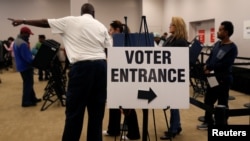For decades, major U.S. media have refused to release real-time voting data on election day, fearing it could influence voter decisions or hamper turnout.
But a data startup company called VoteCastr is teaming up with two media outlets to try to break that trend on Tuesday. And not everyone is happy about it.
Beginning at 8:00 a.m. EST, VoteCastr will begin issuing projections of which candidate will win key battleground states, where the race is likely to be decided.
VoteCastr is relying on hundreds of field workers who will monitor turnout in key precincts in Florida, Iowa, New Hampshire, Nevada, Ohio, Pennsylvania and Wisconsin.
So, for instance, if voter turnout is stronger than expected in a rural part of Iowa expected to be friendly to Donald Trump, that may suggest a better chance of victory for the Republican candidate.
It is a significant diversion from the current media practice, by which outlets follow a self-imposed embargo to not release any state projections until the polls have closed in those states.
The theory is that if voters see that their state is likely to go for one candidate over another, they may be influenced to either change their vote or not vote at all.
Some polling experts also question whether the rolling projections are even likely to be reliable, because they depend so heavily on voter turnout figures.
One obstacle is that on election day, voter turnout varies over time, according to Nate Cohn, who writes The Upshot column for The New York Times.
"Younger voters don’t usually vote in the morning, and many voters in 9-to-5 jobs might surge to the polls in the evening," Cohn said in a report on Monday.
"The VoteCastr model makes no effort to adjust for this," he says. "It will treat turnout as if it's uniform throughout the day."
But VoteCastr, as well as the two media outlets - Slate and Vice News - which will publish the projections, have defended their model, even if they acknowledge it is not perfect.
"When it comes to who might win, the emphasis should be on might," said a Slate article describing the VoteCastr projections. "There are too many unknowns for us to be able to say with confidence that what we think is happening in the present will continue to happen in the future."
And as for the question of whether the data may influence voters, those behind the project say they aren't concerned. They say voters already have been inundated with data, and many may already know how their state is likely to vote.
"The role of journalists is to bring information to people, not protect them from it," said Slate chief editor Julia Turner.




























